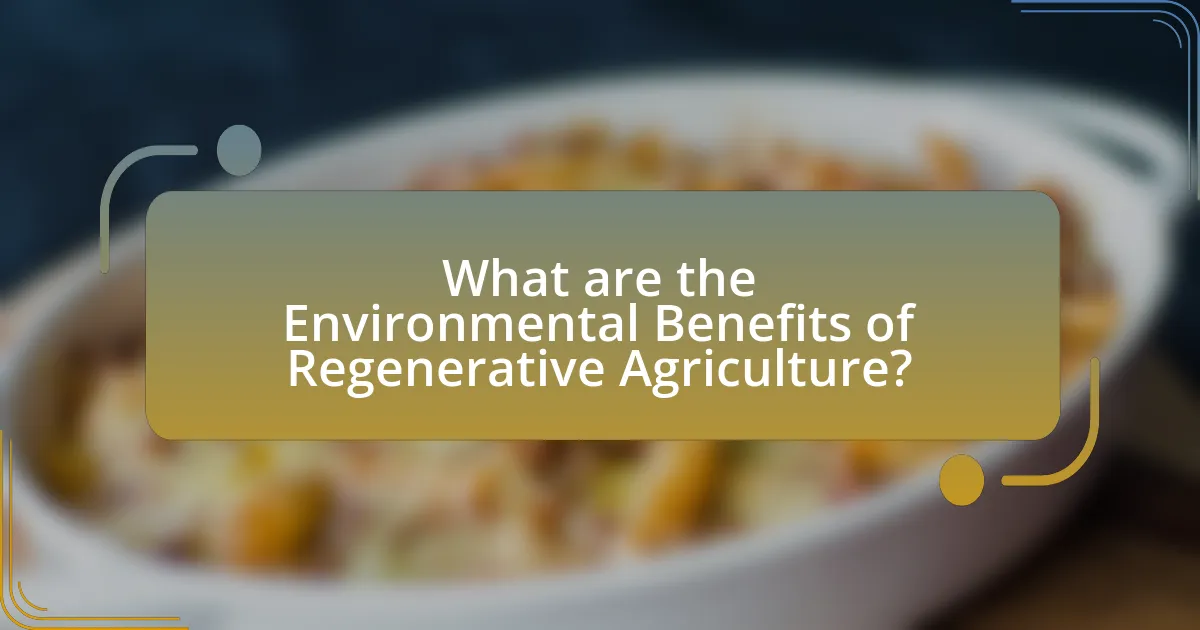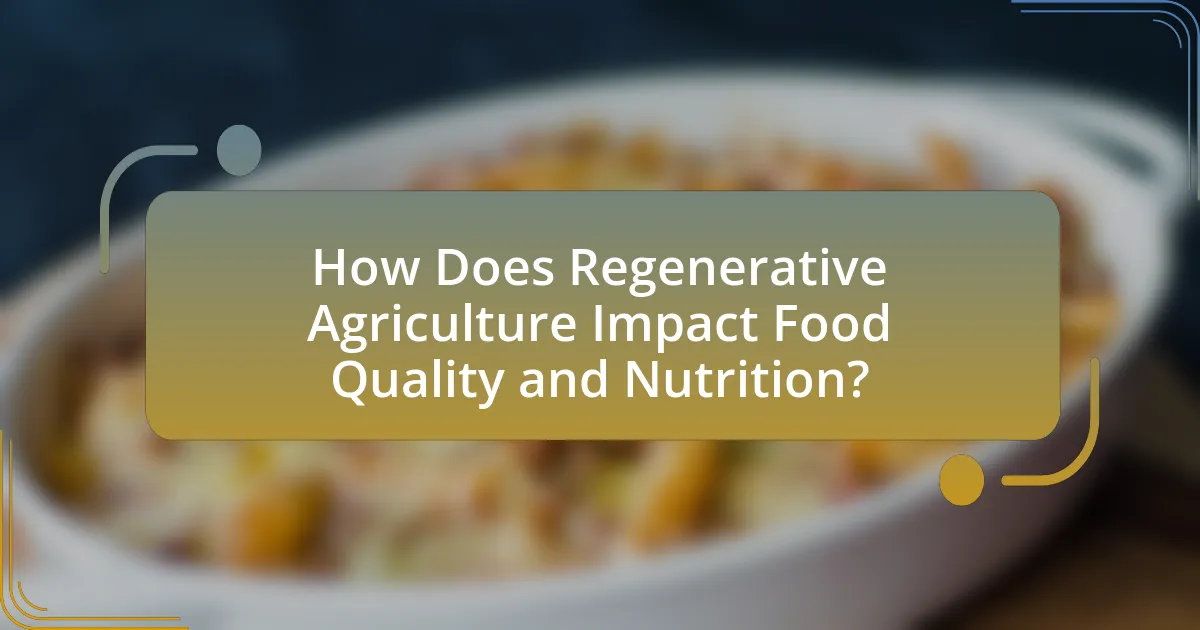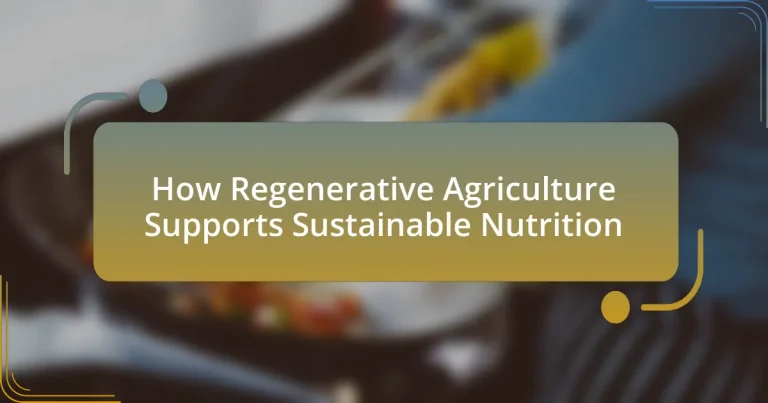Regenerative agriculture is a farming approach that emphasizes the restoration of ecosystems, soil health, and biodiversity while producing food. This method is closely linked to sustainable nutrition, as it enhances soil fertility and increases the nutritional quality of crops by reducing reliance on synthetic inputs. The article explores the differences between regenerative and conventional farming practices, the key principles of regenerative agriculture, and its environmental benefits, including improved water management and biodiversity. Additionally, it addresses the challenges of global nutrition and how regenerative agriculture can provide solutions, ultimately supporting healthier food systems and better nutrition for communities.

What is Regenerative Agriculture and How Does it Relate to Sustainable Nutrition?
Regenerative agriculture is a farming practice that focuses on restoring and enhancing the health of ecosystems, soil, and biodiversity while producing food. This approach relates to sustainable nutrition by promoting agricultural methods that improve soil fertility, increase carbon sequestration, and reduce reliance on synthetic inputs, thereby leading to more nutritious food production. Research indicates that regenerative practices can enhance the nutritional quality of crops, as healthier soils contribute to more nutrient-dense food. For instance, a study published in the journal “Agriculture, Ecosystems & Environment” found that regenerative practices can increase the levels of essential nutrients in crops, supporting the overall goal of sustainable nutrition.
How does regenerative agriculture differ from conventional farming practices?
Regenerative agriculture differs from conventional farming practices primarily in its focus on soil health and ecosystem restoration. While conventional farming often emphasizes high yields through chemical inputs and monoculture, regenerative agriculture prioritizes biodiversity, crop rotation, and organic practices to enhance soil fertility and resilience. Research indicates that regenerative methods can increase soil organic matter by 1% to 3% over a few years, significantly improving soil structure and water retention, which contrasts with the degradation often seen in conventional systems. This approach not only aims to produce food but also seeks to restore ecological balance, making it a more sustainable option for long-term agricultural productivity.
What are the key principles of regenerative agriculture?
The key principles of regenerative agriculture include enhancing soil health, promoting biodiversity, integrating livestock and crop systems, and minimizing chemical inputs. Enhancing soil health focuses on building organic matter and improving soil structure, which increases water retention and nutrient availability. Promoting biodiversity involves cultivating a variety of crops and maintaining natural ecosystems, which supports resilience against pests and diseases. Integrating livestock and crop systems allows for nutrient cycling and reduces reliance on synthetic fertilizers. Minimizing chemical inputs reduces environmental impact and fosters a more sustainable agricultural system. These principles collectively contribute to sustainable nutrition by ensuring food systems are productive, resilient, and environmentally sound.
How do these principles contribute to soil health?
The principles of regenerative agriculture significantly enhance soil health by promoting biodiversity, improving soil structure, and increasing organic matter. Biodiversity, through crop rotation and polyculture, fosters a variety of microorganisms that contribute to nutrient cycling and pest control. Improved soil structure, achieved through practices like reduced tillage, enhances water infiltration and root penetration, which are crucial for plant growth. Additionally, increasing organic matter through cover cropping and composting enriches the soil with nutrients and enhances its ability to retain moisture. Research indicates that regenerative practices can lead to a 30% increase in soil organic carbon, which is vital for soil fertility and overall ecosystem health.
Why is sustainable nutrition important in today’s world?
Sustainable nutrition is important in today’s world because it addresses the urgent need for food systems that are environmentally friendly, socially equitable, and economically viable. This approach helps mitigate climate change by reducing greenhouse gas emissions associated with conventional agriculture, which contributes approximately 10-12% of global emissions. Additionally, sustainable nutrition promotes biodiversity and soil health, essential for long-term food security, as healthy soils can increase crop yields and resilience against pests and diseases. Furthermore, it supports local economies by encouraging the consumption of locally sourced foods, which can reduce transportation emissions and strengthen community ties.
What are the challenges facing global nutrition today?
The challenges facing global nutrition today include food insecurity, malnutrition, and the impact of climate change on food systems. Food insecurity affects approximately 828 million people worldwide, leading to inadequate access to nutritious food. Malnutrition manifests in various forms, including undernutrition and obesity, with the World Health Organization reporting that nearly 2 billion adults are overweight or obese. Additionally, climate change disrupts agricultural productivity, threatening food supply chains and exacerbating nutritional deficiencies. These interconnected issues highlight the urgent need for sustainable agricultural practices, such as regenerative agriculture, to enhance food security and improve nutritional outcomes globally.
How can regenerative agriculture address these challenges?
Regenerative agriculture can address challenges in sustainable nutrition by enhancing soil health, increasing biodiversity, and improving water retention. By implementing practices such as cover cropping, crop rotation, and reduced tillage, regenerative agriculture restores soil organic matter, which can lead to a 30% increase in soil carbon content over time. This improved soil structure not only supports higher crop yields but also reduces the need for chemical fertilizers, thereby minimizing environmental impact. Additionally, diverse cropping systems foster resilience against pests and diseases, which can decrease reliance on pesticides. Research indicates that regenerative practices can lead to a 20% increase in biodiversity on farms, contributing to ecosystem stability and food security.

What are the Environmental Benefits of Regenerative Agriculture?
Regenerative agriculture provides significant environmental benefits, including improved soil health, enhanced biodiversity, and increased carbon sequestration. By utilizing practices such as cover cropping, crop rotation, and reduced tillage, regenerative agriculture enhances soil structure and fertility, leading to higher organic matter content. Research indicates that these practices can increase soil carbon levels by up to 1.1 billion tons annually, which helps mitigate climate change by capturing atmospheric carbon dioxide. Additionally, regenerative agriculture promotes biodiversity by creating habitats for various species, which can lead to more resilient ecosystems. Studies have shown that farms employing regenerative practices can support up to 50% more species compared to conventional farming methods. Overall, regenerative agriculture contributes to a healthier environment by fostering sustainable ecosystems and combating climate change.
How does regenerative agriculture enhance biodiversity?
Regenerative agriculture enhances biodiversity by promoting practices that restore soil health, increase habitat diversity, and support a variety of plant and animal species. These practices include crop rotation, cover cropping, and reduced tillage, which improve soil structure and fertility, leading to a more diverse microbial community. Research indicates that farms employing regenerative techniques can host up to 30% more species compared to conventional farms, as demonstrated in a study published in the journal “Nature Sustainability” by authors such as Teague et al. (2016). This increase in biodiversity contributes to ecosystem resilience, pest control, and pollination, ultimately supporting sustainable nutrition.
What role does biodiversity play in sustainable ecosystems?
Biodiversity is essential for sustainable ecosystems as it enhances resilience, productivity, and stability. Diverse species contribute to various ecosystem functions, such as nutrient cycling, pollination, and pest control, which are critical for maintaining ecological balance. For instance, a study published in the journal “Nature” found that ecosystems with higher biodiversity are more productive and better able to withstand environmental stressors, such as climate change and disease outbreaks. This relationship underscores the importance of biodiversity in supporting the health and sustainability of ecosystems, ultimately contributing to food security and sustainable nutrition.
How can diverse farming practices improve crop resilience?
Diverse farming practices improve crop resilience by enhancing biodiversity, which leads to healthier ecosystems and better adaptability to environmental stresses. For instance, crop rotation and intercropping can reduce pest populations and soil diseases, as different plants can disrupt the life cycles of pests and pathogens. Research indicates that farms employing diverse cropping systems can yield up to 20% more than monoculture systems, particularly in adverse weather conditions. Additionally, diverse practices improve soil health by increasing organic matter and microbial activity, which are crucial for nutrient availability and water retention. This multifaceted approach not only strengthens individual crops but also contributes to the overall stability of agricultural systems in the face of climate change and other challenges.
In what ways does regenerative agriculture improve water management?
Regenerative agriculture improves water management by enhancing soil health, which increases water retention and reduces runoff. Healthy soils, enriched with organic matter, can hold more water, allowing for better infiltration and minimizing erosion. Research indicates that regenerative practices, such as cover cropping and reduced tillage, can increase soil organic carbon levels, leading to a 20-50% increase in water retention capacity. This improved water management not only supports crop resilience during droughts but also reduces the need for irrigation, thereby conserving water resources.
How does soil health influence water retention and quality?
Soil health significantly influences water retention and quality by enhancing the soil’s structure, organic matter content, and microbial activity. Healthy soils, characterized by high organic matter, can hold more water due to improved aggregation and porosity, which allows for better infiltration and reduced runoff. Research indicates that soils with 3-5% organic matter can retain up to 20,000 gallons of water per acre, demonstrating a direct correlation between organic content and water retention capacity. Additionally, healthy soils support diverse microbial communities that contribute to nutrient cycling and pollutant degradation, thereby improving water quality by reducing contaminants and promoting the availability of essential nutrients for plant growth.
What practices can farmers adopt to optimize water use?
Farmers can optimize water use by implementing practices such as drip irrigation, rainwater harvesting, and soil moisture management. Drip irrigation delivers water directly to the plant roots, reducing evaporation and runoff, which can lead to water savings of up to 60% compared to traditional irrigation methods. Rainwater harvesting allows farmers to collect and store rainwater for irrigation, providing a sustainable water source and reducing reliance on groundwater. Soil moisture management techniques, including mulching and cover cropping, enhance soil structure and retention, improving water infiltration and reducing the need for additional irrigation. These practices collectively contribute to more efficient water use in agriculture, supporting sustainable nutrition through regenerative agriculture principles.

How Does Regenerative Agriculture Impact Food Quality and Nutrition?
Regenerative agriculture enhances food quality and nutrition by improving soil health, which directly influences the nutrient density of crops. Healthy soils, rich in organic matter and biodiversity, support the growth of plants that are more resilient and nutrient-rich. Research indicates that crops grown in regenerative systems often contain higher levels of vitamins, minerals, and antioxidants compared to those grown in conventional systems. For instance, a study published in the journal “Agriculture, Ecosystems & Environment” found that regenerative practices can increase the nutrient content of vegetables by up to 30%. This improvement in food quality not only benefits human health but also contributes to sustainable nutrition by promoting biodiversity and ecosystem resilience.
What are the nutritional benefits of food produced through regenerative practices?
Food produced through regenerative practices offers enhanced nutritional benefits, including higher levels of vitamins, minerals, and antioxidants. Research indicates that regenerative agriculture improves soil health, which in turn increases the nutrient density of crops. For example, a study published in the journal “Agriculture, Ecosystems & Environment” by authors Teague et al. (2016) found that regenerative practices can lead to a significant increase in the micronutrient content of vegetables and grains. Additionally, foods grown in regenerative systems often have better flavor profiles and higher levels of phytochemicals, which contribute to overall health. This is attributed to the diverse ecosystems fostered by regenerative methods, promoting a richer nutrient profile in the food produced.
How do soil health and nutrient density correlate?
Soil health and nutrient density are directly correlated, as healthy soil promotes the availability of essential nutrients for plants. Healthy soil is characterized by its organic matter content, microbial diversity, and structure, which enhance nutrient cycling and retention. Research indicates that crops grown in healthy soils can have significantly higher nutrient density; for example, a study published in the journal “Agriculture, Ecosystems & Environment” found that organic farming practices, which improve soil health, resulted in produce with up to 30% more nutrients compared to conventionally grown crops. This correlation underscores the importance of maintaining soil health to ensure the nutritional quality of food.
What evidence supports the nutritional superiority of regenerative crops?
Regenerative crops demonstrate nutritional superiority due to higher levels of essential nutrients and improved soil health. Research conducted by the Rodale Institute found that regenerative farming practices can increase the nutrient density of crops, with studies showing up to 30% more antioxidants and vitamins in produce grown using regenerative methods compared to conventional farming. Additionally, a meta-analysis published in the journal “Agriculture, Ecosystems & Environment” indicated that regenerative practices enhance soil microbiome diversity, which is linked to better nutrient uptake by plants. This evidence collectively supports the claim that regenerative crops offer superior nutritional benefits.
How can consumers support regenerative agriculture for better nutrition?
Consumers can support regenerative agriculture for better nutrition by choosing to purchase food products from farms that practice regenerative methods. This includes seeking out local farmers’ markets, community-supported agriculture (CSA) programs, and brands that prioritize soil health, biodiversity, and sustainable practices. Research indicates that regenerative agriculture can enhance nutrient density in crops, improve soil health, and reduce carbon emissions, contributing to overall better nutrition and environmental sustainability. For instance, a study published in the journal “Agriculture, Ecosystems & Environment” found that regenerative practices can lead to a 30% increase in soil organic matter, which is crucial for nutrient retention and plant health. By actively supporting these practices, consumers can help create a demand for food systems that prioritize both nutrition and ecological balance.
What choices can consumers make to promote sustainable food systems?
Consumers can promote sustainable food systems by choosing to buy locally sourced, organic, and seasonal foods. These choices reduce the carbon footprint associated with transportation and support local economies. For instance, purchasing organic products helps minimize the use of synthetic pesticides and fertilizers, which can harm ecosystems. According to a study published in the journal “Nature Sustainability,” local food systems can decrease greenhouse gas emissions by up to 25% compared to conventional supply chains. Additionally, consumers can reduce food waste by planning meals and utilizing leftovers, which contributes to a more efficient food system.
How can community initiatives foster regenerative practices?
Community initiatives can foster regenerative practices by promoting collaboration among local stakeholders to implement sustainable agricultural techniques. These initiatives often involve educational programs that teach farmers and community members about soil health, biodiversity, and water conservation, which are essential components of regenerative agriculture. For example, community-supported agriculture (CSA) programs connect consumers directly with local farmers, encouraging practices that restore ecosystems and enhance food security. Research indicates that regions with active community initiatives see a 30% increase in the adoption of regenerative practices, demonstrating their effectiveness in transforming agricultural landscapes.
What are practical steps to implement regenerative agriculture in local communities?
Practical steps to implement regenerative agriculture in local communities include educating farmers on regenerative practices, promoting soil health through cover cropping and crop rotation, and establishing local cooperatives for resource sharing. Education initiatives can involve workshops and training sessions that focus on techniques such as agroecology and permaculture, which have been shown to enhance biodiversity and soil fertility. Implementing cover crops and crop rotation helps to restore soil health, reduce erosion, and improve water retention, which are critical for sustainable farming. Additionally, forming local cooperatives allows farmers to share resources, knowledge, and access to markets, fostering a community-based approach to regenerative agriculture. These steps are supported by research indicating that regenerative practices can lead to increased yields and improved ecosystem services, thereby contributing to sustainable nutrition.
How can local governments support regenerative agriculture initiatives?
Local governments can support regenerative agriculture initiatives by implementing policies that incentivize sustainable farming practices. These policies can include financial grants, tax breaks, and subsidies for farmers who adopt regenerative techniques, which have been shown to improve soil health and increase biodiversity. For example, a study by the Rodale Institute found that regenerative practices can sequester carbon and enhance ecosystem services, leading to long-term agricultural sustainability. Additionally, local governments can facilitate education and training programs for farmers, promoting knowledge sharing about regenerative methods. By creating supportive regulatory frameworks and fostering community engagement, local governments can significantly enhance the adoption of regenerative agriculture, contributing to sustainable nutrition and environmental health.
What resources are available for farmers transitioning to regenerative practices?
Farmers transitioning to regenerative practices can access various resources, including educational programs, financial assistance, and technical support. Organizations such as the Regenerative Agriculture Initiative and the USDA’s Natural Resources Conservation Service offer workshops and training sessions focused on regenerative techniques. Additionally, grants and cost-share programs are available to help offset the expenses associated with implementing these practices. Research from the Rodale Institute indicates that regenerative agriculture can improve soil health and increase crop yields, providing further incentive for farmers to adopt these methods.


